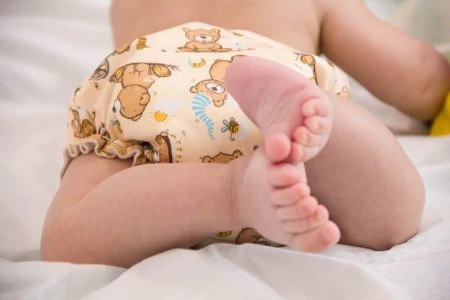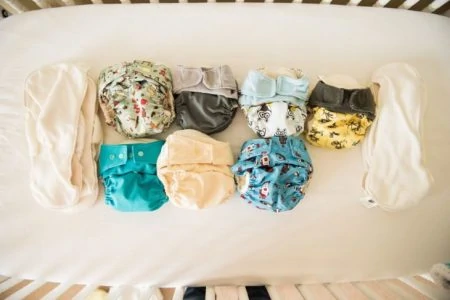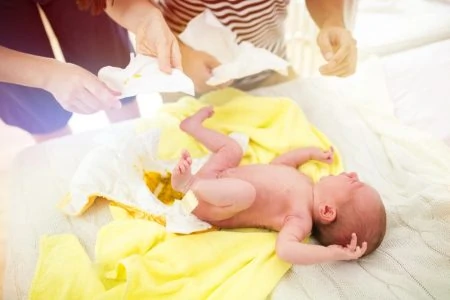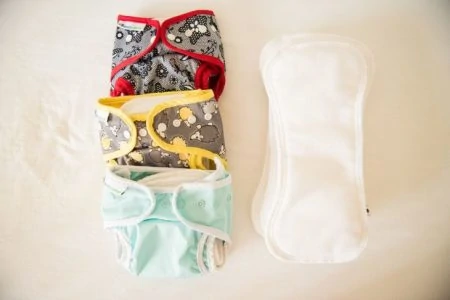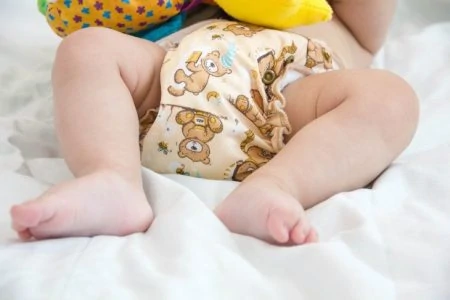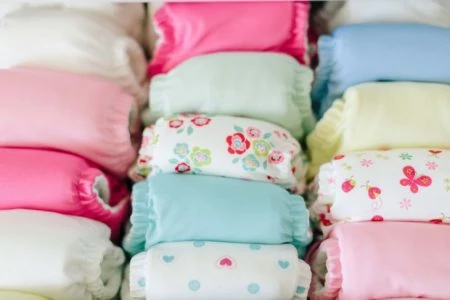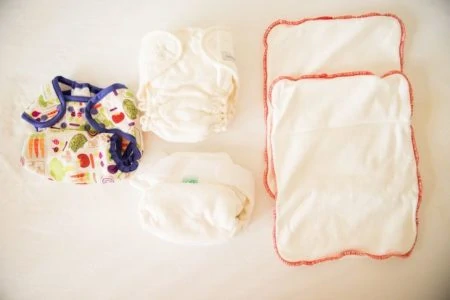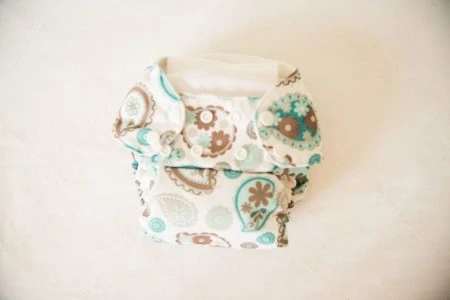Ready to quit cloth diapering because of ammonia, yeast, or mold issues?
We have good news! These problems don’t have to end your cloth diaper journey. Cloth diapers are eco-friendly and cost-effective, so it is worth giving them a fair shot to work for your family.
If your diapers are in desperate need of rescue, it is possible to save them with bleach. Yes, you read that right. Good old-fashioned bleach.
The word makes many cloth diaper users cringe, but the truth is that bleach gets a bad rap. It is an effective tool to prevent and solve all kinds of cloth diapering issues. We have the breakdown on how to use it safely and effectively.
Key Takeaways
- Solves major issues: Bleach soaks are essential for treating used diapers, ammonia buildup, yeast infections, mold, and even insects.
- Monthly maintenance: Periodic bleach soaks can help break down bacteria and prevent detergent buildup before stink issues become permanent.
- The right product: Always use original liquid bleach labeled as a disinfectant or sanitizer (5.25% sodium hypochlorite or higher). Avoid “splashless” varieties.
- Proper method: Bleach clean diapers in cold water first, then follow up with a hot wash and detergent to break down the chemicals.
Why Routinely Bleach Your Diapers?
Bleach is often considered a taboo word in the cloth diaper community. However, many manufacturers actually recommend using it occasionally to keep your stash fresh (1).
Bleaching your diapers once a month can help break down yeast and ammonia. It eliminates odors and prevents detergent buildup before these things become a larger problem that requires tough stripping measures.
Many parents add a small amount of bleach to their wash cycle. Others choose to do a full-on bleach soak just to be safe.
Before You Bleach
When to Bleach Your Cloth Diapers
Routine maintenance is great, but there are specific situations where a bleach soak is non-negotiable. Here is when you need to break out the bottle.
1. You Bought Used Diapers
Buying your diapers pre-loved is a fantastic way to stretch your budget. It is especially helpful when you are new to cloth diapering and want to try different styles to see which works best for your baby.
However, you must do a bleach soak on used diapers before they ever touch your baby.
The previous owner might have used an inadequate wash routine or a detergent that irritates your baby’s skin. If their baby had a yeast rash, spores could transfer to your little one.
There is no way to know the history for sure. It is best to do a bleach soak to hit the reset button.
2. Ammonia Buildup
Ammonia is hard to miss. If you have a problem with it, you will know immediately. The smell will knock you back with an eye-watering fierceness that makes you question using cloth diapers altogether.
Ammonia is usually caused by mineral buildup from hard water, incorrect detergent quantities, or leaving a wet diaper on the baby for too long.
If you smell ammonia in your diapers, you might be tempted to strip them. However, stripping isn’t necessary unless the issue is mineral buildup. A simple bleach soak usually neutralizes the ammonia and solves the smell.
3. Yeast Rash
If your baby has a rash that lasts longer than two days despite keeping them dry and using rash creams, yeast may be the culprit (2). Yeast is stubborn and can affect any baby.
Some sources suggest hot washes, OxiClean, or essential oils. However, the most effective way to kill yeast spores is a bleach soak (3).
Bleach your diapers immediately if your baby has a yeast rash. You will also need to continue adding bleach to your washes for two weeks after the rash clears to prevent reinfection.
4. Mold Growth
Mold loves warm, humid environments. If you leave a wet bag in the car or let diapers sit in the pail too long without airflow, mold spores can bloom.
If you see mold on your diapers, do not throw them out just yet. A bleach soak kills the mold and makes your diapers usable again.
If a standard soak doesn’t remove the staining, you may need a more concentrated bleach soak or an OxiClean treatment to fade the dark spots.
5. Maggots
This makes our skin crawl, but it happens. You can end up with maggots in your cloth diapers if you aren’t careful.
If you leave diapers in the diaper pail for too long or fail to remove solid waste before storage, you create the perfect environment for flies to breed.
Even this nightmare scenario doesn’t mean your diapers are ruined. A rinse in hot water followed by a bleach soak will sanitize everything.
Which Bleach Should I Use?
Not all bottles in the laundry aisle are created equal. You need the right chemical composition to disinfect properly.
Look for original liquid bleach. The label must explicitly state that it disinfects or sanitizes. It should contain at least 5.25% sodium hypochlorite.
Avoid these types:
- Splashless bleach: This formula is too thick and does not disinfect effectively.
- Scented bleach: Added fragrances can cause unnecessary irritation to sensitive skin.
- Color-safe bleach: This is usually peroxide-based and won’t kill the bacteria or yeast we are targeting.
Where Should I Use Bleach?
Start Clean
Your monthly routine does not always have to be a full-on soak. You can sanitize your diapers once a month by adding a quarter cup of chlorine bleach to your warm wash routine. Be sure to rinse your diapers thoroughly after the wash.
An extra rinse is always a good idea — bleach can sometimes irritate a baby’s delicate skin, so make sure to rinse the diapers well!
Editor's Note:
Mary Sweeney, BSN, RN, CENBleaching with a Washing Machine
If you are facing an emergency like mold or yeast, or you just want to ensure your diapers get extra TLC, a soak is the answer.
A top-loading washing machine is the easiest vessel for this task.
Follow these steps to do a bleach soak in a top-loader:
- Fill the washer: Set your washer to fill with cold water. Bleach breaks down too quickly in hot water.
- Add the bleach: Add the correct amount based on your washer size. Small tub: 1/3 cup. Medium tub: 1/2 cup. Large tub: 3/4 cup.
- Soak the diapers: Place your clean diapers in and let them soak for at least 30 minutes. Do not exceed 45 minutes to prevent fabric damage.
- Rinse and wash: Drain the water and run a rinse cycle with hot water. Follow this immediately with a full hot wash cycle using detergent to break down any remaining bleach.
Laundry Tip
Soaking in a Sink or Bathtub
If you have a front-loader, don’t worry. You can use a sink or bucket for small loads or a bathtub for your entire stash.
The routine is generally the same. Soak in cold water with bleach, rinse with hot water, and follow up with a hot machine wash with detergent.
The only thing that changes is the bleach quantity:
- Half-full bathtub: Add 1/2 cup of bleach.
- Full bathtub: Add 1 cup of bleach.
- Sink or bucket: Add 1 tablespoon of bleach per gallon of cold water.
Hard Water and Bleach Soaks
Bleach soaks are excellent for sanitizing, but they can be tricky if you have water with high iron content.
Chlorine reacts with dissolved iron in hard water and causes orange or red stains (4). Note that this applies specifically to iron, not just general calcium hardness.
If you have iron-heavy water, skip the chlorine bleach. Use a mixture of Borax and hydrogen peroxide instead.
For a half-full bathtub of cold water, add four cups of hydrogen peroxide and one cup of Borax. Soak as usual, rinse in hot water, then follow with a hot wash with detergent.
